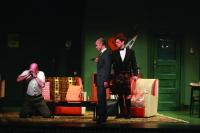
Of three major productions shown in Ireland this spring, The Big Fellah is the most obvious one to review for History Ireland but not necessarily the best. The historical and contemporary resonances of the recent production of Arthur Miller’s The Crucible at the Lyric, Belfast, show the power of theatre to reflect society through the lens of art. Seventeenth-century Puritans with Ulster accents provoke reflection almost of themselves. Likewise the Abbey’s glittering production of Pygmalion reveals the breadth of Shaw’s social commentary as well as his enduring power as a dramatist. More on Shaw in the next issue.
The Big Fellah came here after a very successful run in the West Endbut is having an uncertain reception on this side of the Irish Sea. One wonders how it will be received in Liverpool and Newcastle-on-Tyne. According to the posters the play was described as ‘hilariouslyfunny’ by the Daily Telegraph, an unusual accolade for a play containingtorture, betrayal and murder.

Of course,the play’s cathartic intensity needed interludes of laughter to relieve the tension, but was it thought that there was something intrinsically funny about the antics of a group of IRA terrorists and their Irish-American supporters? Certainly there is no doubt about the seriousness of Richard Bean’s play and Max Stafford-Clark’s direction. It is also unusual to find a play with Irishthemes written by an English playwright performed by a British company in Ireland. The perspective on John Bull’s other island is so often the other way around that we ought to give this play some consideration.
It would be quite easy to dismiss The Big Fellah because of its shortcomings, but it is also worth putting these aside to consider the play’s strengths. One of the rather odd things about it is the way in which the director chose to present it in the style of an Irish kitchen-sink drama. Stafford-Clark studied in Dublin in the sixties and onecouldn’t help wondering whether there was an element of hommage to the Irish tradition in the staging of the play.

(All images: Out of Joint Theatre Company)
How else to explain the almost complete lack of movement on stage, the two-dimensional fourth wall of the stage and the fact that only the dialogue—and indeed monologues—carried the play forward. There was, amazingly, a slight problem with Irish and Irish-American accents, and certainly nothing like the brilliance of, for example, Anna Manahan in Brian Friel’s Cass Maguire. But the play is one of ideas and to some extent overcomes its limitations by the pace and power of the acting.
The basic elements revolve around the figure of the ‘big fellah’—a fundraiser for Noraid driven by a passionate resentment of British treatment of the Northern Irish minority in the 1970s and 1980s, raising funds and shipping arms to Ireland, providing a safe house in New York for Irish republicans and ultimately losing his faith in the cause because he comes at some point to see that his idealism has led him into a moral nightmare. The historical elements in the play are interesting in themselves, although the production had difficulty making a convincing representation of the passage of time.
As we get closer to the present, the entire look of the characters is transformed by the impact of the events of 11 September 2001. The Irish-Americans are caught in the contradictions of waging a war on terror while sponsoring it in Ireland. Their remoteness from the realities of Ireland having already been established by their murder of a republican feminist, the cause they believed in ceases to make sense as Ireland gropes towards peace while America embarks on its eternal war in the shadows. This seems to bring us to the heart of the play and suggests that it isn’t really or mainly about Ireland at all, but about the complex reactions of the English-speaking world to the invention of the war on terror as a state of perpetual war waged asymmetrically against an enemy almost impossible to define—is it a person, a nation, a country, a religion? Nobody seems to know. This is precisely the dilemma confronting the West, and particularly the so-called Anglosphere, since 2001. The contradictions are particularly strong in the case of Britain, following Blair and Brown’s decision to follow America unconditionally. The Irish case would also be involved with this contradiction if we chose to have a policy on the war on terror as opposed to the cynical and mendacious tergiversations of the Ahern years.
This realisation that the collapse of the Twin Towers is by far the most important event in the play doesn’t take away from its reflection on the Irish troubles and their American context. Insularity and xenophobia are not, of course, the sole preserve of Irish-America, as is very clear from the terrifying portrayal of the IRA enforcer Frank McAdle by David Rintoul. And the Irish context, as we need to keep reminding ourselves, cannot be understood in isolation from the greater forces shaping the world unless we wish to keep repeating the same mistakes. The same applies to Britain, of course, which is why the absence of a British voice in the play is intriguing, especially as some elements of the IRA reflect the kind of British view which was regularly served up in the editorial pages of the New York Times in the 1970s and ’80s, before a different part of Irish-America helped to change the agenda. The theatre of ideas doesn’t always make great theatre, but it is thought-provoking, if sometimes jarring, and certainly worth seeing. HI
